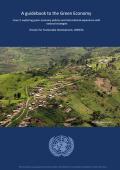
Green economy in the context of sustainable development and poverty eradication was one of two themes at the UN Conference on Sustainable Development held in Rio de Janeiro in June 2012 (or Rio+20).
Negotiations on green economy in the lead up to Rio+20 were challenging and the concept became a source of controversy and disagreement. Despite these challenges, governments agreed at Rio+20 to frame the green economy as an important tool for sustainable development; one that is inclusive and can drive economic growth, employment, and poverty eradication, whilst maintaining the healthy functioning of the Earth’s ecosystems. Importantly, the outcome document also recognises that capacity building, information exchange and experience sharing will be critical for implementing green economy policies. In this context, the document invites the UN to work with partners to provide support to developing countries and to develop toolboxes, best practices, methodologies and models to aid green economy policy design and implementation.
In this Issue 4 of A Guidebook to the Green Economy, the focus turns to the various international initiatives that are supporting countries and stakeholders to implement the green economy worldwide by providing a range of services including information exchange, data management, capacity building, finance, and technology services. In doing so, it provides a resource guide to the various existing international green economy platforms, partnerships, programs, funds and other initiatives. The guidebook also aims to map out many of the key actors involved in implementing and supporting the various green economy initiatives, the key services that they provide to countries, and the geographical reach of these initiatives which are now spreading the green economy across the globe. The intent is to provide useful information to practitioners, countries and stakeholders which may assist with coordination and coherence and help countries to find the support that they need. As with the previous UNDESA guidebooks, the review focuses on green economy and the related concepts of green growth and low-carbon development.
Environmental information transparency performs social and learning functions indispensable for green growth. Still facing the challenges of a lack of local commitment and less than optimal institutional capacity, China has made substantial progress on granting and enforcing the public right to environmental information. This will help build the social infrastructure necessary for green growth — the rule of law, trust, social organizing, consensus building, social learning, and collective action. A focused approach is desirable because resources and capacity are limited in China — targeting pollutants and sectors that exert the most environmental and health risks as well as those that need technological upgrade most urgently. Then, in the long run, environmental information transparency serves the fundamental goals of ‘good public policy and legitimate governmental decision-making’ on environment-related issues in China, in line with both the green growth framework and the long-term development goal of constructing a harmonious society in China.
